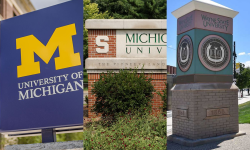College enrollments stay down in Michigan. Blame paychecks and the pandemic?

- About 52.8 percent of the high school class of 2022 enrolled in a two or four year college within six months of graduating
- That is a significantly lower rate than pre-pandemic and still lower than the class of 2020 and 2021
- Experts say the fallout of COVID and high wages are likely contributors to the trend
College enrollment by last year’s high school graduates is still well below pre-pandemic levels, as 52.8 percent of the class of 2022 went to college within the six months of graduation, data released Thursday shows.
That’s down from an average of 62.9 percent in the three years preceding the COVID-19 pandemic, and means as many as 10,000 fewer high school graduates chose college last fall.
“The question is: is this a culture shift or is this COVID fallout?” said Jamie Jacobs, deputy director at the Michigan College Access Network.
With wages in Michigan rising, especially for the lowest paid, experts say many students may have chosen a paycheck over college.
Related:
- Whitmer pitches Reconnect expansion
- 2021: As Gretchen Whitmer pitches Michigan education, a lag in college enrollment
- 2020: As COVID spread, far fewer Michigan high school grads enrolled in college
Two-year schools were hurt the most, where just 15.8 percent of 2022 high school grads chose to enroll, down from an average of 23.5 percent from 2017-19, according to the latest college enrollment numbers compiled by Michigan’s Center for Educational Performance and Instruction.
Michigan Community College Association Vice President Erica Orians told Bridge Michigan the numbers are a “deep concern.”
“Especially as Michigan is thinking about moving more to an information economy and, you know, more advanced manufacturing… a lot of that training happens at community colleges,” she said.
Enrollment rates at four-year schools fell, but not as much, from an average of 39.4 percent from 2017-19 to 37 percent last fall.
To compile the data, the state compares the lists of high school graduates to a national database of college students.
The data comes as Gov. Gretchen Whitmer and others are calling for an expansion of programs to make college more accessible, but the numbers pose the question: Will more aid make any difference?
The data showed that enrollment rates, which first fell substantially in 2020 as the pandemic raged and the vaccines were yet to be rolled up, fell across the nation and in Michigan.
That could have long-running implications for a state that is trying to dramatically increase the number of college graduates in Michigan to improve incomes.
Michigan’s median household income, $63,498 in 2021, is about 10 percent below the national median of $69,717. In 2013 Michigan had a higher median but it has fallen behind the national median every year since.
Few high schools districts were immune from the declines, suggesting widespread changes in how students and their parents view the decision to attend college. Counselors need to remind students several times to fill out crucial financial aid forms, said Jacobs. The 2021-22 school year, there were COVID-19 disruptions that limited those contacts.
“We also know that students spent several years with a lot less requirements and a lot less folks bugging them,” Jacobs said.
Paycheck or backpack?
Then there’s the economy: Minimum wage might officially be $10.10 in Michigan but many if not most are paying well above that, pushing wages close to those of some college graduates.
“(The) labor market has extreme demands right now and you can get a job that pays $25 an hour, and you don’t need educational requirements,” Colby Cesaro, vice president of Michigan Colleges and Universities, a group that works with 25 nonprofit independent colleges and universities.
Despite booming paychecks, Cesaro and others say the financial incentive for college remains: A high school grad makes about, on average, $18,000, or $25,000 fewer than a college grad. After five years that gap grows to over $30,000.
“If you have a degree, you are less likely to lose your job and if you do lose your job, you’re more likely to pivot and do something different,” Cesaro said. “And the challenge here is when you have fewer and fewer of your low income population going to college in the first place…I think it’s just a broader issue when we have another recession.”
A big change looms that could have a positive impact on enrollment rates: The state will begin offering its Michigan Achievement scholarships that will give up to $5,500 a year to attend a state public university. Students can also receive up to $2,750 a year to attend community college and $4,000 a year to attend a private nonprofit school.
That could help the most economically disadvantaged, who Cesaro said have seen the biggest enrollment drop.
From 2013-14 to 2020-21, she said the number of college students in Michigan fell nearly 20 percent, from 533,551 to 428,723.
But those students eligible for Pell grants, which are awarded to those with the most financial need, fell 37 percent to 128,683 from 205,703 over that time.
Whitmer has made receiving a degree or training certificate after high school a cornerstone of her agenda. She has a goal of having 60 percent of working age adults with a post high school degree or certificate by 2030. The rate is now 49 percent.
At her State of the State speech Wednesday night, she pitched expanding the state’s tuition-free community college program known as Michigan Reconnect to people as young as 21 years old. Currently, adults 25 and older who don’t yet have a degree are eligible for help.
Michigan Education Watch
Michigan Education Watch is made possible by generous financial support from:
Subscribe to Michigan Health Watch
See what new members are saying about why they donated to Bridge Michigan:
- “In order for this information to be accurate and unbiased it must be underwritten by its readers, not by special interests.” - Larry S.
- “Not many other media sources report on the topics Bridge does.” - Susan B.
- “Your journalism is outstanding and rare these days.” - Mark S.
If you want to ensure the future of nonpartisan, nonprofit Michigan journalism, please become a member today. You, too, will be asked why you donated and maybe we'll feature your quote next time!





